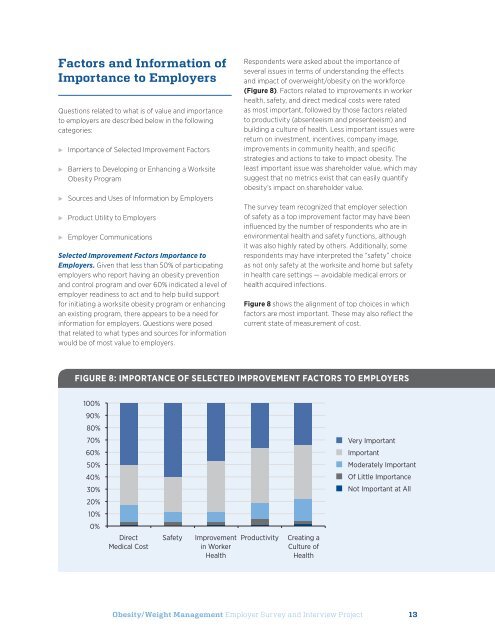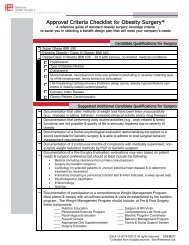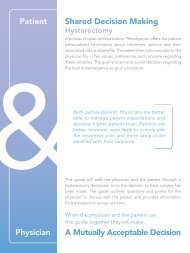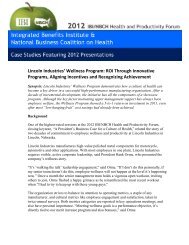Obesity/Weight Management Employer Survey and Interview Project
Obesity/Weight Management Employer Survey and Interview Project
Obesity/Weight Management Employer Survey and Interview Project
- No tags were found...
Create successful ePaper yourself
Turn your PDF publications into a flip-book with our unique Google optimized e-Paper software.
Factors <strong>and</strong> Information ofImportance to <strong>Employer</strong>sQuestions related to what is of value <strong>and</strong> importanceto employers are described below in the followingcategories:E Importance of Selected Improvement FactorsE Barriers to Developing or Enhancing a Worksite<strong>Obesity</strong> ProgramE Sources <strong>and</strong> Uses of Information by <strong>Employer</strong>sE Product Utility to <strong>Employer</strong>sE <strong>Employer</strong> CommunicationsSelected Improvement Factors Importance to<strong>Employer</strong>s. Given that less than 50% of participatingemployers who report having an obesity prevention<strong>and</strong> control program <strong>and</strong> over 60% indicated a level ofemployer readiness to act <strong>and</strong> to help build supportfor initiating a worksite obesity program or enhancingan existing program, there appears to be a need forinformation for employers. Questions were posedthat related to what types <strong>and</strong> sources for informationwould be of most value to employers.Respondents were asked about the importance ofseveral issues in terms of underst<strong>and</strong>ing the effects<strong>and</strong> impact of overweight/obesity on the workforce(Figure 8). Factors related to improvements in workerhealth, safety, <strong>and</strong> direct medical costs were ratedas most important, followed by those factors relatedto productivity (absenteeism <strong>and</strong> presenteeism) <strong>and</strong>building a culture of health. Less important issues werereturn on investment, incentives, company image,improvements in community health, <strong>and</strong> specificstrategies <strong>and</strong> actions to take to impact obesity. Theleast important issue was shareholder value, which maysuggest that no metrics exist that can easily quantifyobesity’s impact on shareholder value.The survey team recognized that employer selectionof safety as a top improvement factor may have beeninfluenced by the number of respondents who are inenvironmental health <strong>and</strong> safety functions, althoughit was also highly rated by others. Additionally, somerespondents may have interpreted the “safety” choiceas not only safety at the worksite <strong>and</strong> home but safetyin health care settings — avoidable medical errors orhealth acquired infections.Figure 8 shows the alignment of top choices in whichfactors are most important. These may also reflect thecurrent state of measurement of cost.Figure 8: Importance of Selected Improvement Factors to <strong>Employer</strong>sVery ImportantImportantModerately ImportantOf Little ImportanceNot Important at All100%90%80%70%60%50%40%30%20%10%0%DirectMedical CostSafetyImprovementin WorkerHealthProductivityCreating aCulture ofHealth<strong>Obesity</strong>/<strong>Weight</strong> <strong>Management</strong> <strong>Employer</strong> <strong>Survey</strong> <strong>and</strong> <strong>Interview</strong> <strong>Project</strong> 13









